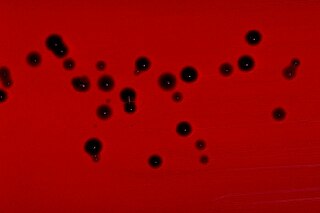
Burkholderia is a genus of Proteobacteria whose pathogenic members include the Burkholderia cepacia complex, which attacks humans and Burkholderia mallei, responsible for glanders, a disease that occurs mostly in horses and related animals; Burkholderia pseudomallei, causative agent of melioidosis; and Burkholderia cepacia, an important pathogen of pulmonary infections in people with cystic fibrosis (CF). Burkholderia species is also found marine environment. S.I. Paul et al. (2021) isolated and characterized Burkholderia cepacia from marine sponges of the Saint Martin's Island of the Bay of Bengal, Bangladesh.

The Burkholderiaceae are a family of bacteria included in the order Burkholderiales. It includes some pathogenic species, such as Burkholderia mallei (glanders) and Burkholderia pseudomallei (melioidosis).

Burkholderia pseudomallei is a Gram-negative, bipolar, aerobic, motile rod-shaped bacterium. It is a soil-dwelling bacterium endemic in tropical and subtropical regions worldwide, particularly in Thailand and northern Australia. It infects humans and other animals and causes the disease melioidosis. It is also capable of infecting plants.

Burkholderia mallei is a Gram-negative, bipolar, aerobic bacterium, a human and animal pathogen of genus Burkholderia causing glanders; the Latin name of this disease (malleus) gave its name to the species causing it. It is closely related to B. pseudomallei, and by multilocus sequence typing it is a subspecies of B. pseudomallei.B. mallei evolved from B. pseudomallei by selective reduction and deletions from the B. pseudomallei genome. Unlike B. pseudomallei and other genus members, B. mallei is nonmotile; its shape is coccobacillary measuring some 1.5–3.0 μm in length and 0.5–1.0 μm in diameter with rounded ends.

Chromobacterium violaceum is a Gram-negative, facultative anaerobic, non-sporing coccobacillus. It is motile with the help of a single flagellum which is located at the pole of the coccobacillus. Usually, there are one or two more lateral flagella as well. It is part of the normal flora of water and soil of tropical and sub-tropical regions of the world. It produces a natural antibiotic called violacein, which may be useful for the treatment of colon and other cancers. It grows readily on nutrient agar, producing distinctive smooth low convex colonies with a dark violet metallic sheen. Some strains of the bacteria which do not produce this pigment have also been reported. It has the ability to break down tarballs.

Burkholderia thailandensis is a nonfermenting motile, Gram-negative bacillus that occurs naturally in soil. It is closely related to Burkholderia pseudomallei, but unlike B. pseudomallei, it only rarely causes disease in humans or animals. The lethal inoculum is approximately 1000 times higher than for B. pseudomallei. It is usually distinguished from B. pseudomallei by its ability to assimilate arabinose. Other differences between these species include lipopolysaccharide composition, colony morphology, and differences in metabolism.

Ashdown's medium is a selective culture medium for the isolation and characterisation of Burkholderia pseudomallei.
Paraburkholderia bannensis is a Gram-negative, aerobic, non-spore-forming bacterium of the genus Paraburkholderia and the family Burkholderiaceae, which was isolated from highly acidic swamps from torpedo grass in Thailand. It has the ability to neutralize acid.
Paraburkholderia ginsengisoli is a gram-negative, rod-shaped, motile bacterium with unipolar polytrichous flagella from the genus Paraburkholderia and the family Burkholderiaceae which was isolated from soil of a ginseng field in South Korea. Paraburkholderia ginsengisoli has the ability to produce β-glucosidase.
Paraburkholderia heleia is a gram-negative, nitrogen-fixing, aerobic, non-spore-forming, rod-shaped bacterium from the genus Paraburkholderia and the family Burkholderiaceae which was isolated from the Chinese water chestnut Eleocharis dulcis in acid sulfate soil areas of Vietnam. Colonies of Burkholderia heleia are pale yellow.
Paraburkholderia silvatlantica is a gram-negative, catalase and oxidase-positive nitrogen-fixing bacterium from the genus Paraburkholderia and the family Burkholderiaceae which was isolated from the rhizosphere of maize in Seropédica in Rio de Janeiro. Colonies of Paraburkholderia silvatlantica are cream-coloured with yellow in the centre.
Paraburkholderia soli is a gram-negative, catalase and oxidase-positive strictly aerobic, non motile bacterium from the genus Paraburkholderia and the family Burkholderiaceae which was isolated from soil and cultivated with Korean ginseng.
Caballeronia zhejiangensis is a Gram-negative, non-spore-forming, rod-shaped bacterium from the genus Caballeronia, which was isolated from a wastewater treatment system in China. Caballeronia zhejiangensis has the ability to degrade methyl parathion.
Burkholderia contaminans is a gram-negative, bacterium from the genus of Burkholderia and the family of Burkholderiaceae and belongs to the Burkholderia cepacia complex, which was isolated from cystic fibrosis patients in Argentina. Burkholderia acidipaludis can cause biliary sepsis.
Burkholderia lata is a bacterium from the genus of Burkholderia and the family of Burkholderiaceae which belongs to the Burkholderia cepacia complex.
Burkholderia latens is a gram-negative, aerobic, non-spore-forming bacterium from the genus of Burkholderia and the family of Burkholderiaceae which belongs to the Burkholderia cepacia complex. Colonies of Burkholderia latens are moist.
Burkholderia seminalis is a gram-negative, aerobic, non-spore-forming, bacterium from the genus Burkholderia and the family Burkholderiaceae which belongs to the Burkholderia cepacia complex.
Paraburkholderia insulsa is a Gram-negative, acidophilic, rod-shaped, arsenic-tolerant and aerobic bacterium from the genus of Burkholderia which has been isolated from the Ambitle Island on Papua New Guinea.
Paraburkholderia monticola is a Gram-negative, short-rod-shaped and aerobic bacterium from the genus Paraburkholderia which has been isolated from soil from the Gwanak Mountain in Korea.
Paraburkholderia susongensis is a Gram-negative bacterium from the genus Paraburkholderia which has been isolated from a weathered rock surface in Susong in the Anhui Province in China.




